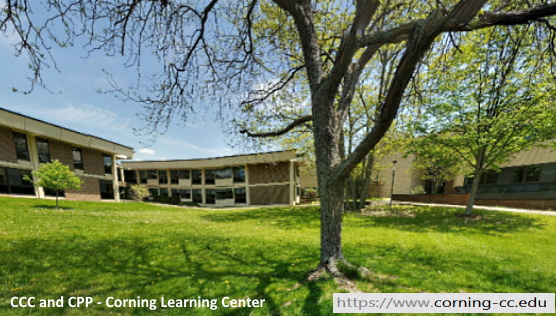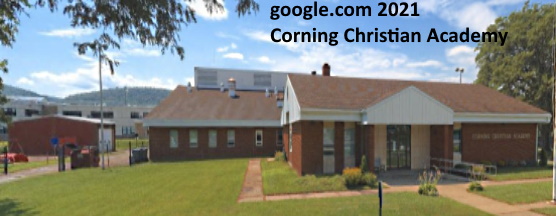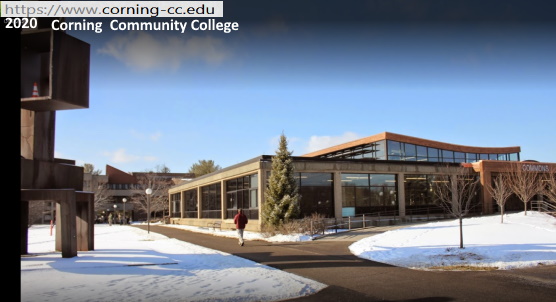Corning History
The first settlement was near the current city of Corning around 1789. The Town of Corning began as the "Town of Painted Post" in 1796 when the county was founded.In 1836, the name was changed to honor an important investor in the local economy. It is named for Erastus Corning, an Albany financier and railroad executive who was an investor in the company that developed the community. The community of Corning set itself apart as a village in 1848 and became a city in 1890. Source: https://en.wikipedia.org/wiki/Corning_(town),_New_York
East, across the Chemung River from Corning, lies Gibson, the site of a feeder canal for the Chemung Canal system. Some of Corning's early prosperity came from the feeder canal system exposure. Canal cargoes from Corning included soft coal, timber, tobacco, grain, and whiskey. After the Civil War, an industrial boom occurred in the region. Ingersoll Rand opened during this period in Painted Post, just north of Corning. Corning became a railroad town in the 1880s.
The Corning area's first real industry was lumber. The first settlers used the area's river systems to transport logs and finished lumber in fleets downstream to buyers. This gave rise to large mills which helped to develop the area. Rafting of lumber began to wane as timber was depleted. At one time the mills of the Corning area were reputed to be among the biggest in the world. After the lumber was depleted the great mills moved north to new forests.
When the Brooklyn Flint Glass Works moved here in the late 1860s from Brooklyn, NY, it was renamed the Corning Glass Works. The company now is named Corning Incorporated. Now known as America's Crystal City, Corning has long been at the forefront of all things glass, from innovative technology and science (think light bulbs for Thomas Edison, and modern wonders like fiber optics and Gorilla Glass) to the remarkable creations found at The Corning Museum of Glass, the world's largest museum of glass art and artifacts. But artisan glass is just one of the reasons Corning is so fun. Corning Glass produced some of the finest American Brilliant Period cut glass between 1880 and 1915.
The flood of 1972 was a major event for the area. On June 22, 1972, the storm that had been Hurricane Agnes struck the Southern Tier of New York. In the Corning area, eighteen people were killed and untold millions of dollars of damage was incurred. The river receded within hours, leaving mud which can still be found in basements of homes and businesses in Corning, and there is a section of the Corning Museum of Glass that indicates on the wall how high the flood waters rose. The river is prone to floods, as rain water runs off quickly from the steep hillsides of the area. Flooding is now controlled by a system of dams upstream from Corning. As other communities destroyed their downtowns after the flood of 1972, Corning restored, preserved, and revitalized into the dynamic destination we enjoy today. The Market Street Restoration Agency prides itself on its continuous efforts to maintain and improve the historical integrity of Corning's Gaffer District.
The racial makeup [in 2010] of the city was 91.8% White, 3.2% Black or African American, 0.3% Native American, 1.8% Asian, Hispanic or Latino of any race were 2.4% of the population. 4.1% speak a language other than English at home.
Since 1995, the City of Corning operates under the Council-Manager form of government.
Corning has three sister cities, as designated by Sister Cities International:
- Lviv, Ukraine
- Kakegawa, Shizuoka, Japan (formerly Osuka which was annexed by Kakegawa)
- San Giovanni Valdarno, Tuscany, Italy
- CorningFingerlakes.com [History Corning]
- Wikipedia.org [City of Corning]
- CorningNYHistory.com
- GreenerPasture.com [Corning History]
- GafferDistrict.com [City of Cornin]
- LibGuides.cmog.org [City of Corning History]
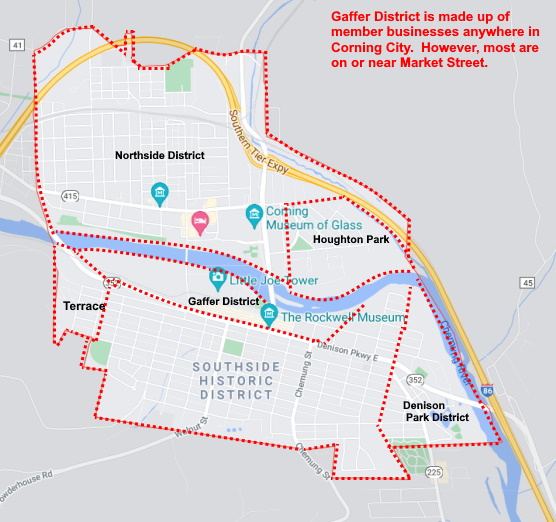
Communities and locations in the City of Corning:
- Northside [use to be called Knoxville] is north of the Chemung River and mostly inside the Rt 86 highway loop [Southerntier Expressway].
- Houghton Park is north of the Chemung River to the East of the Northside.
- Gaffer District is South of the Chemung River and includes Market St and City of Corning businesses
- Southside Historic District [or Southside] is located South of Denison Parkway to the outskirts of the boundry of the City of Corning [above 6th St and Upper Delevan Dr.]
- Terrace Residential is located west of the Southside Historic District and West of Field St.
- Denison Park includes the Park area as well as East of Columbia St and McMahon Ave.
Northside [Knoxville]
The Northside was initially called Knoxville. As Knoxville, it was a village separately from Corning. In 1796, land agent Charles Williamson built an in on West Pulteney St and installed Benjamin Patterson as innkeeper. This road was the road to the "West" in those days. The village grew from this beginning. In 1873, developement was mostly between Dodge St and Sly St. In 1890, Knoxville and the Southside [Corning] merged into one city. After the merger, the area grew quickly.Source: Leader.com [Historic Walking Tour: Northside
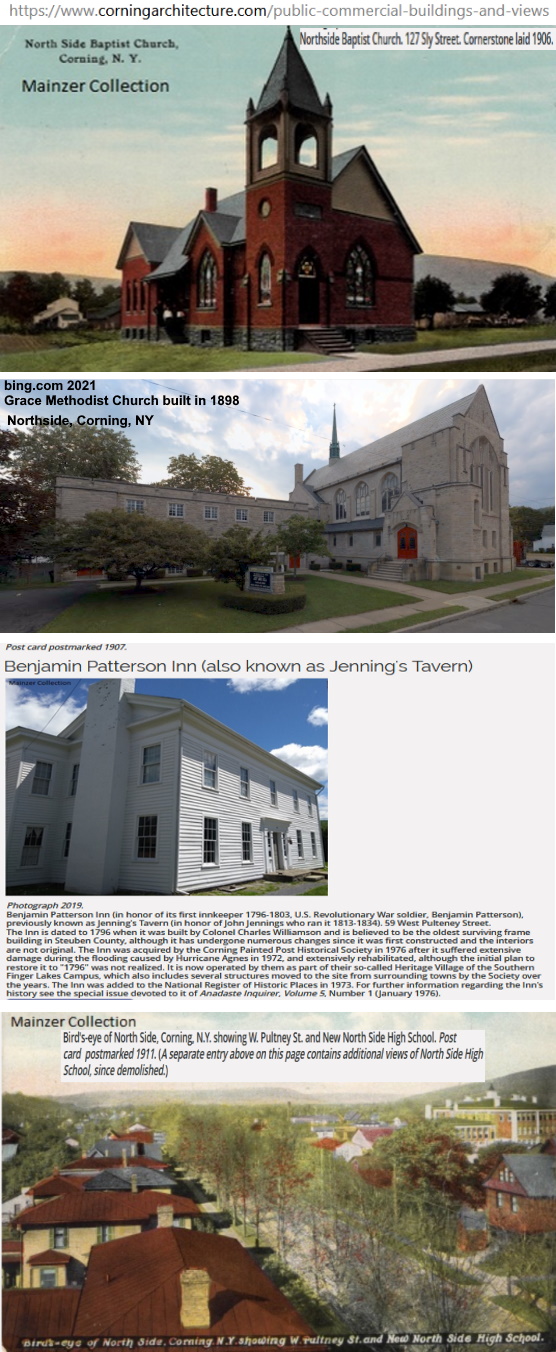
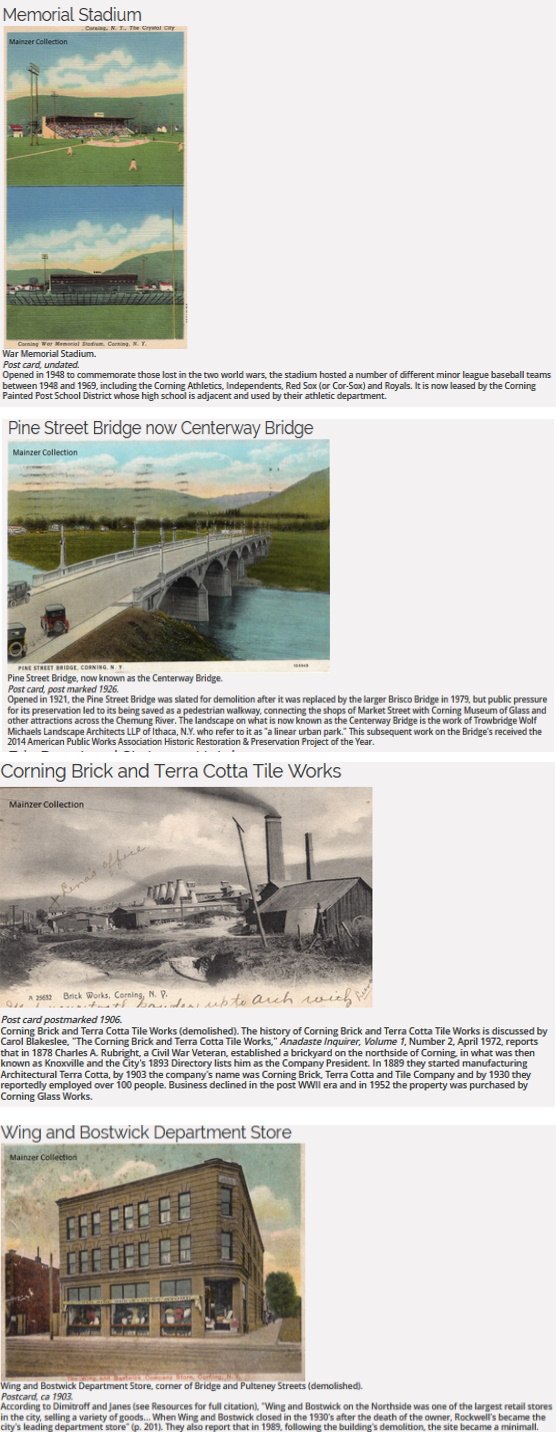
Houghton Park
The Houghton family, the founders of Corning Inc., owned the plot when it was an undeveloped piece of farmland. Officials said workers from the then Corning Flint Glass Works and other area glassmaking companies dumped waste glass and ceramics at the site until the early 20th century, when the area was covered with topsoil and homes were built. The contamination was initially found during the 2012-2013 Corning-Painted Post High School expansion projectThe City of Corning has a long history of manufacturing, and is world renowned for its glassmaking. Historical references indicate that, in the late 1800s and early 1900s, the City of Corning was home to a large brick manufacturer and more than sixty (60) former glass manufacturers. The most enduring of these enterprises is Corning Incorporated, whose history dates to 1868 when the company founder established the Corning Flint Glass Works in Corning, New York. While the company has grown and expanded through the years and changed names to Corning Glass Works and currently to Corning Incorporated, the corporate headquarters has remained in Corning, New York.
In the late 1800s, coal was the primary fuel source in the Corning, New York area, and most of the local industries used coal to heat their furnaces. In the early 1900s natural gas was introduced to the region, and Corning Glass Works, along with many other industries and municipalities, started converting their fuel sources to natural gas. The exact years during which this conversion occurred for Corning Glass Works are not known.
During the years when coal was widely used by various industrial and domestic entities as a fuel source, it was not uncommon practice for the construction and demolition debris, including brick, ash and other materials, to be used as fill to improve drainage and to fill in low lying areas as an aid to development.
Through a title search of property deeds, it was found that the Study Area was located on part of lands previously owned by Corning Homes, Inc., which had acquired these properties in 1920 from the heirs of the then-deceased founder of Corning Flint Glass Works. The deeds for these properties contained a condition that allowed Corning Glass Works to maintain structures, buildings and "ash dumps as now located" on the properties. Despite a thorough review of available historical documents and public records, Corning Incorporated has not, to date, located any maps or records that depict the potential location, if any, of the "ash dumps" as referenced in the deeds (i.e., as of 1920). In 1937, Corning Homes, Inc. sold portions of the properties with the same conditional language included, which has never been extinguished. Corning Homes, Inc. has no relation to Corning Incorporated or any of its predecessors.
In June 2020, an ISMP was established for OU3. The ISMP defines the inspection, reporting, and investigation requirements for OU3 and includes procedures for handling and disposing contaminated material. If Subject Material is encountered during a capital improvement project, Corning Incorporated Corning Painted Post School District, Corning Christian Academy, and the City Corning must adhere to the ISMP and the Excavation Work Plan (Appendix B) to ensure the public and worker safety during investigation, delineation, removal, and restoration efforts. Furthermore, this ISMP will ensure a cover system is in place to prevent contact with subject material.
For the Study Area, an ISMP is required during pre-design, design and remedial activities that are consistent with site management for properties (including rights of way and utility corridors). The ISMP is intended to address all soil management issues until the remedy is fully implemented and will terminate once all properties where access was granted are remediated and a Department-approved SMP is in place.
Work in the Houghton Plot, which is bounded by Pyrex Street, East Pulteney Street, Post Creek, and the Chemung River, is being completed by Corning Inc., under a consent order with the state DEC. Cleanup of the area will continue into 2024.
Source:
History of Houghton Park Area
Weny.com [Houghton Cleanup Begins Article]
Leader [Houghton Park Cleanup Article]
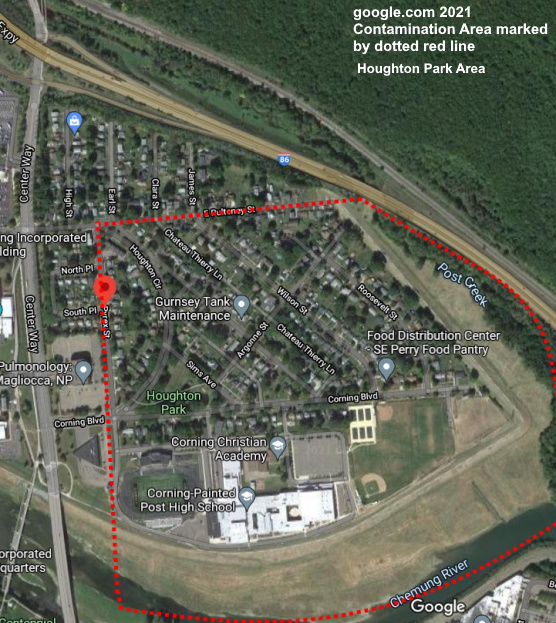
Gaffer District
In 1796, the Southside [City of Corning] was mostly farmland with a few scattered houses. In 1890, the Northside and Southside merged and both began to grow prosper. Prior to 1972, businesses and such existed on Market St and in other locations in the City of Corning. In 1974, the Market Street Restoration Agency (MSRA) was established to guide the revitalization of downtown Corning following the flood of 1972. Corning relying on a movement toward historic preservation, which had begun before the flood, to keep the City's character in place. Corning's renewal, led by Norman Mintz, working together with the merchants, business and property owners became the gold standard for revitalizing an historic downtown.In the early 1980s, Corning Enterprises joined the effort at the forefront of this transformation, providing vision, leadership, and resources to the community. However, what started as a restoration initiative from the flood soon blossomed into a collaboration of agencies working on advancing the economic development, quality of life, and historic preservation of Corning's downtown. In the late 1980s, Corning Enterprises led the way in revitalizing Corning's downtown by recruiting major retailers to Market Street.
In 1995, MSRA felt that it was important to continue its leadership role in main street revitalization by illustrating the vitality garnered in a downtown by revitalizing its upper floors for residential use. It was also vital to historic commercial buildings that require maintenance as they age. Over the next five years, MSRA Executive Director Elise Johnson-Schmidt rallied the support of the City, State Building Code officials, Corning Enterprises, Three Rivers Development, and the property owners to build the necessary support to embark upon the development of upper floors for market-rate housing.
The result was a comprehensive strategy that consolidated the resources of several agencies and created a single vision for the future of the downtown and the establishment of Corning's Gaffer District.
The area is called the Gaffer District in honor of the highly-skilled glass-blowing artisans who create unique glass pieces in all sizes, shapes and colors. Corning has a very small-town feel to it.
Source: Gaffer District [History]
Leader.com [Historic Walking Tour: Northside
Wine Country Getaways [Gaffr District Info]
Facebook: Gaffer District
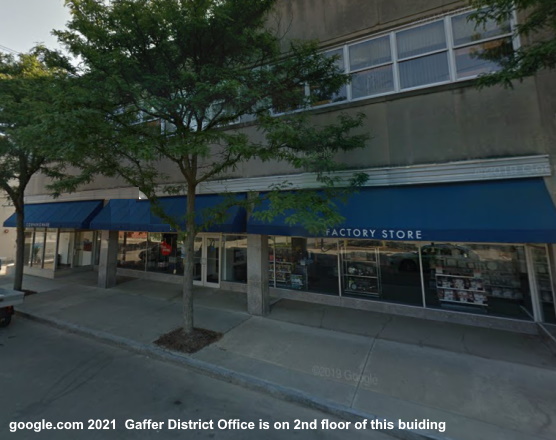
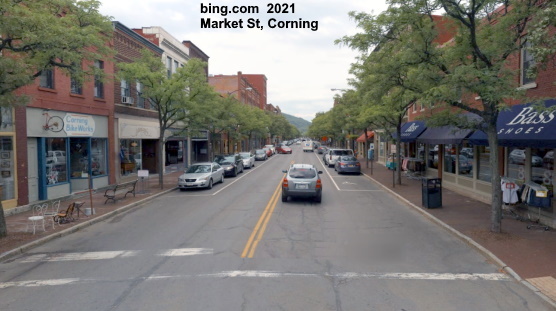
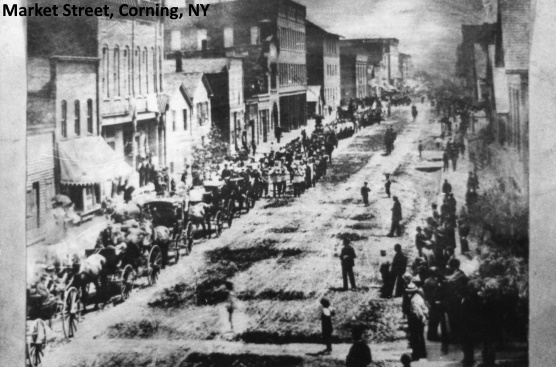

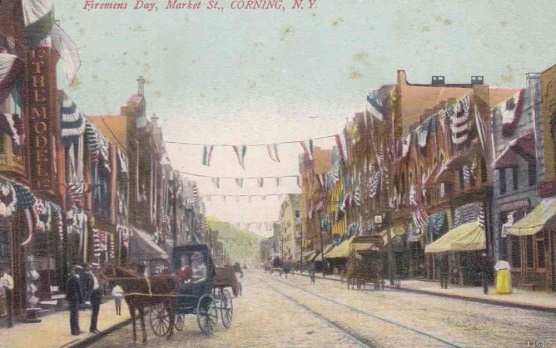
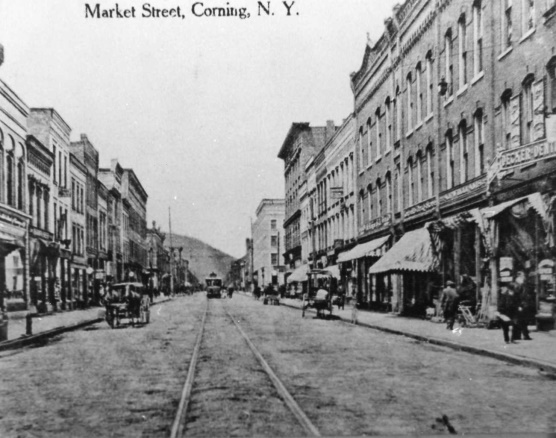
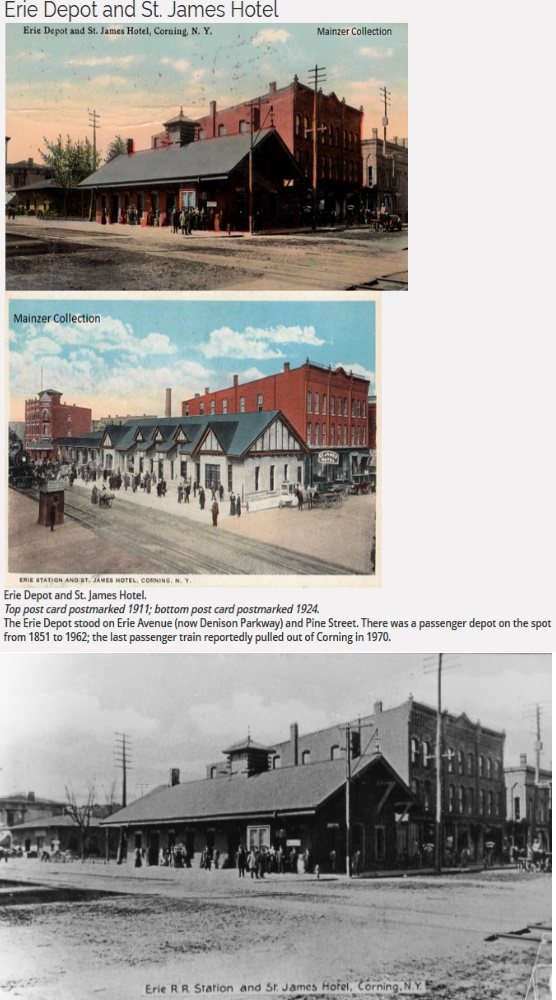
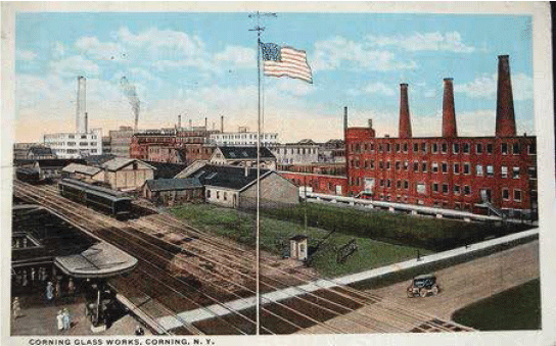
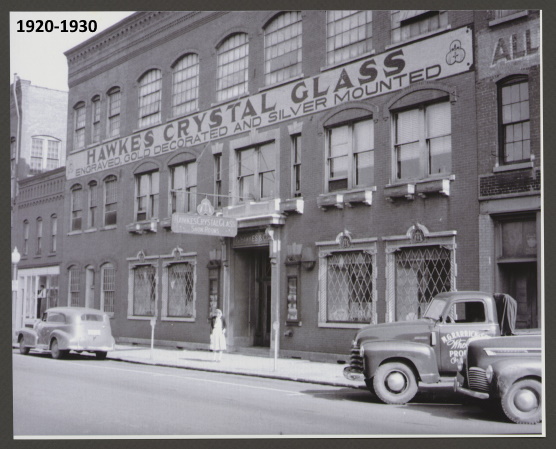
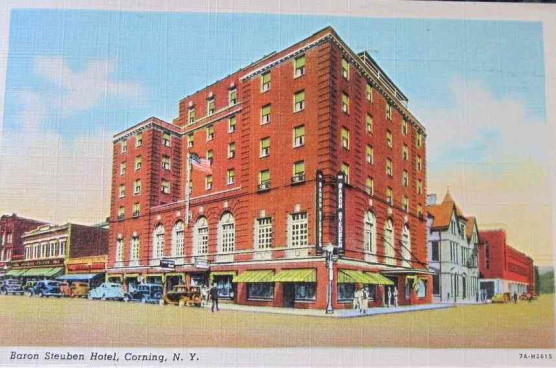
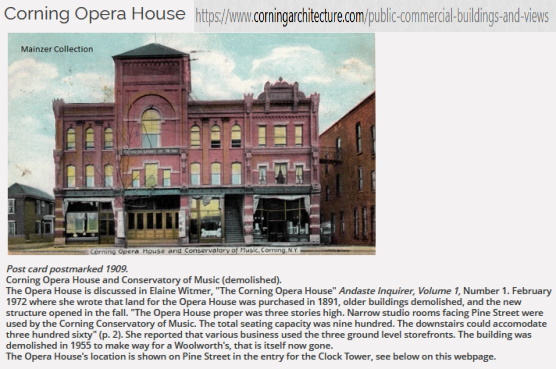
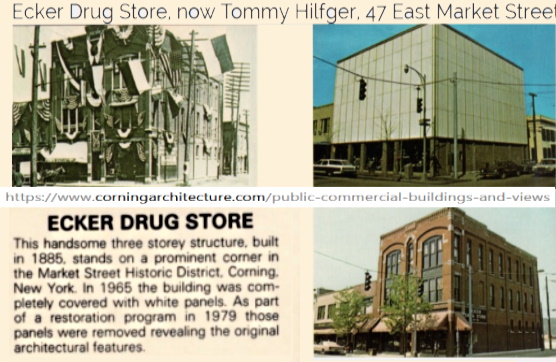
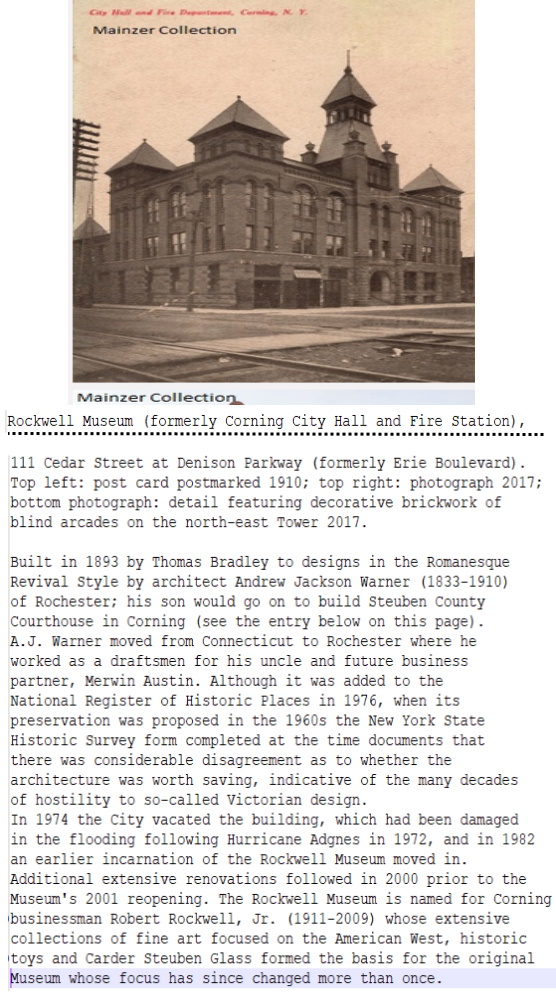
CPP Historical Society [CPPHS]
The Corning Painted Post Historical Society (CPPHS) was founded in 1947 "to collect local historical data, to diffuse the knowledge of local history, and to promote... the (1948) centenary of the incorporation of Corning as a village." It began immediately collecting information about the community's past.In 1976, the Society acquired and restored as a Bicentennial project the dilapidated 1796 structure once known as the Painted Post Tavern. Located at 73 West Pulteney Street, Corning, it oversees today the Heritage Village of the Southern Finger Lakes which include the Benjamin Patterson Inn and other buildings moved to the site for restoration as the museum grew.
The CPPHS continues to collect local historical information and artifacts. Its place in the museum community is established, with living history programs reaching annually over 5,800 visitors. Source: HeritageVillagesFl.org [Corning History]
Southside Historic District
In 1796, the Southside [of the City of Corning], was mostly farmlands with a few scattered houses. In 1890, the Northside and Southside merged and both began to grow prosper.Southside Historic District is a national historic district located at Corning, Steuben County, New York. Southside Historic District (added 1998 - - #98000137) Roughly bounded by NY 17, Chemung St., Spencer Hill, and Washington St., Corning, NY. It is extensively residential as well.
The district encompasses 624 contributing buildings, one contributing site and four contributing objects in a predominantly residential section of Corning. The district developed after 1835 and includes notable examples of Federal, Greek Revival, and Victorian architecture. Located in the district is the separately listed World War Memorial Library. Other notable buildings include the Steuben County Courthouse designed by J. Foster Warner, the " Voting Booth" (c. 1893-1898), Corning Free Academy (1922), the First United Methodist Church of Corning and Christ Episcopal Church. The Southside Neighborhood Association’s mission is to celebrate and share the historic Southside neighborhood and the history of Corning, New York. The Southside neighborhood has over 400 homes within a nationally designated historic district.
Source:
RoadTrippers.com [Southside Historic District History]
Facebook: Southside Historic District
CorningSNS.org [Southside Historic Info]
Wikipedia.org [Southside Historic Distric, Corning, NY]
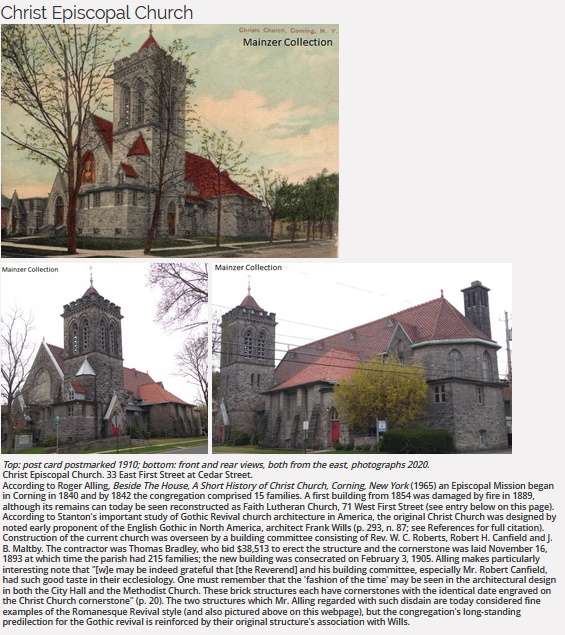
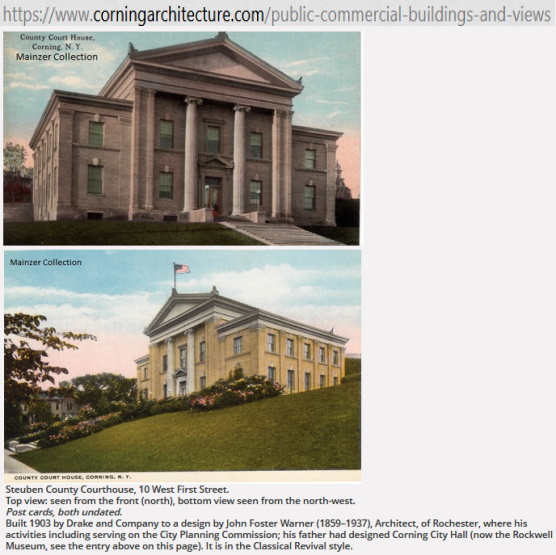
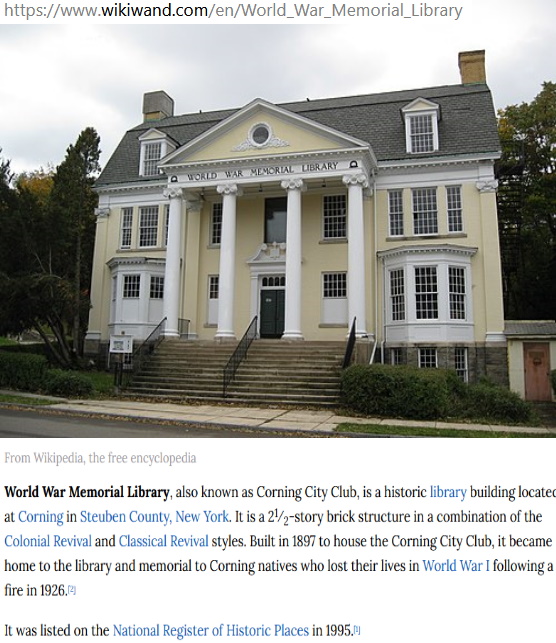
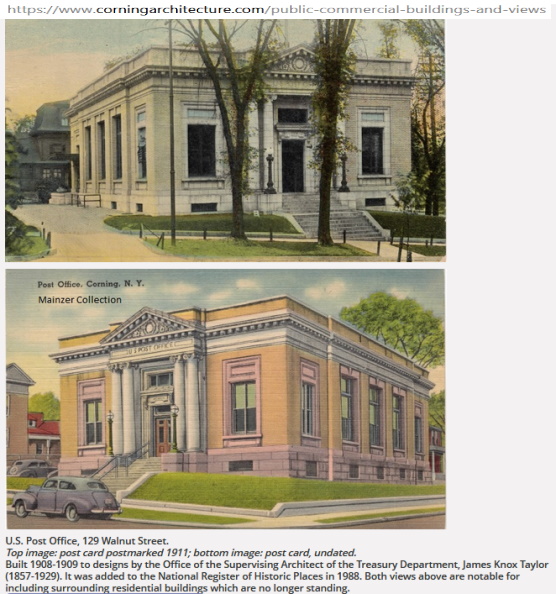
Terrace Residential
It is a residential and apartment area built in more recent times.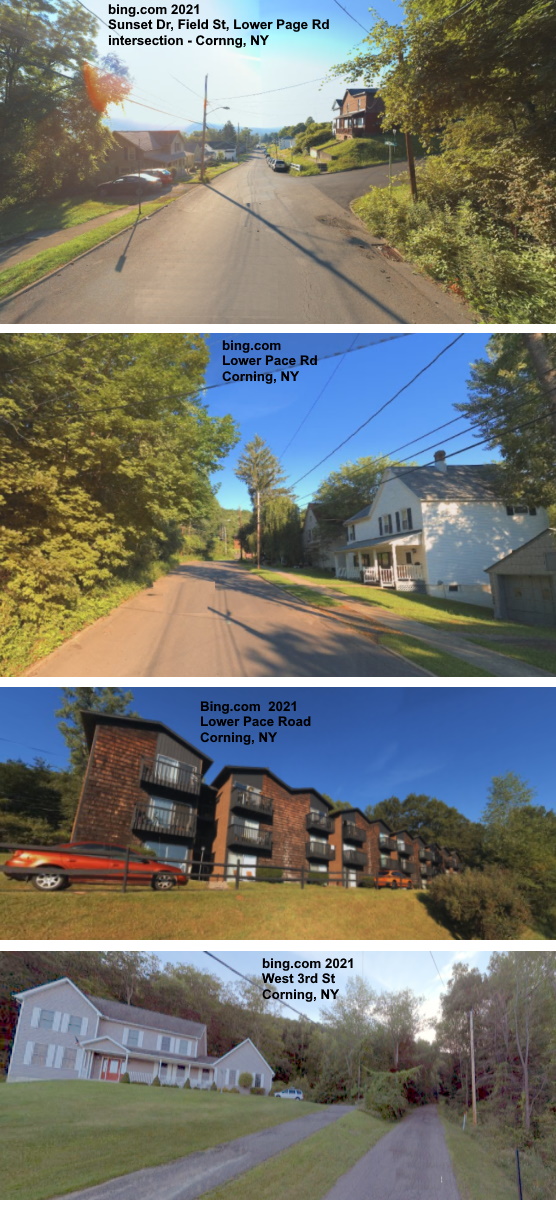

Denison Park
Erected by the Citizens of Corning, N. Y. in memory of C. G. Denison the father of C. L. Denison a true friend of Corning whose bountiful gift made the Denison Park possible.Denison Park History
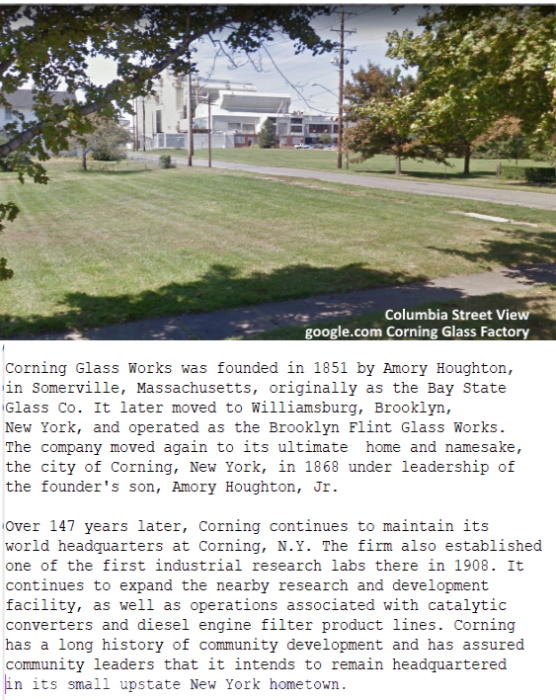
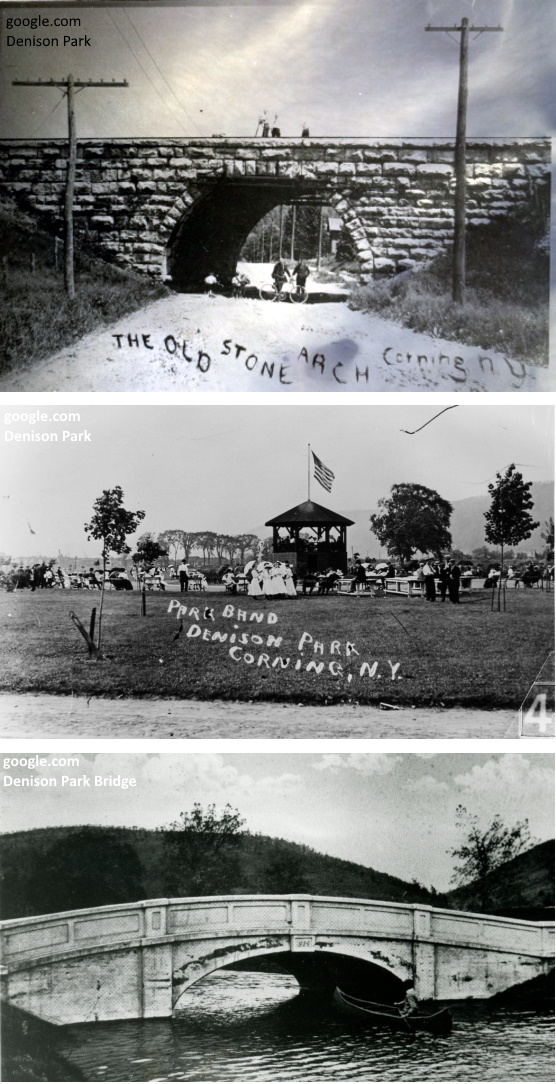
School History
Catholic Schools
Corning, New York has a long and proud tradition of Catholic education. St. Mary’s School, (the predecessor of All Saints Academy), was established in Corning, in 1855 by the mostly Irish immigrant parishioners of St. Mary’s Church. For the first five years, the school conducted classes in the basement of the church, which was built in 1849. In 1860, St. Mary’s Parish organized a great fair to raise funds for a new school building. The new St. Mary’s School building opened in 1861, with a staff of two lay teachers. Enrollment grew quickly, and by 1862 there were 250 students enrolled. In 1867, the Sisters of Mercy arrived to take over teaching duties of the ever expanding student population. Most Corning residents had never seen a nun before the sisters arrived. By 1881, the school had outgrown its original building, and a new 2-story brick school was built. By 1908, there were 595 students enrolled at St. Mary’s, and in 1911 a new addition to the building provided more classrooms, an auditorium, a library, and the first gymnasium in Corning. This historic brick building today houses the junior high classrooms and the gymnasium/cafeteria of All Saints Academy.In 1903, St. Patrick’s Church in Corning also built a school, which grew quickly. By 1908, 241 were enrolled. St. Vincent’s Church on the city’s north side built their school in 1914. Most of St. Vincent’s parishioners were of Italian descent.
In 1971, St. Mary’s School and St. Patrick’s School combined to become Catholic School South, housed in the former St. Mary’s School. At the same time, St. Vincent’s School was renamed Catholic School North. In 1980, Catholic School South and Catholic School North combined to become All Saints Academy, at the historic St. Mary’s School site. Source: ASACorning.org [History]
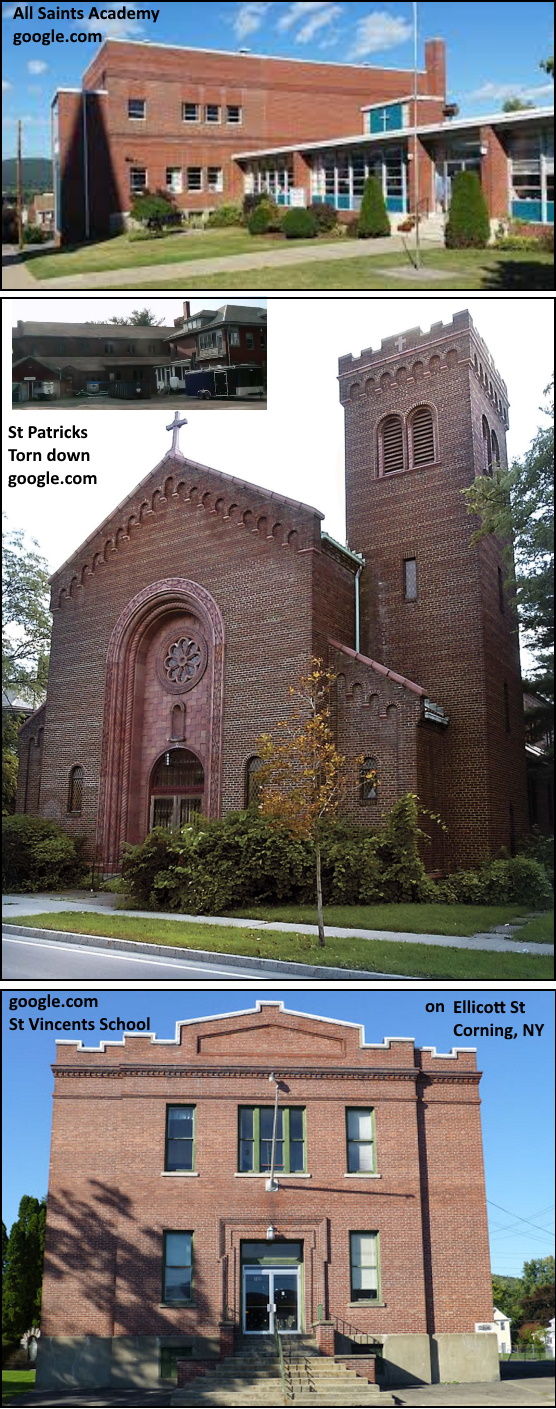

Corning Christian Academy
Corning Christian Academy is a cooperative ministry providing Christian Education. CLC opened its doors to twenty-one K-third grade pupils in September 1982 in the Beartown Road C & M A Church in Gang Mills. Grades 4-6 were added in September 1983, when the school moved to the old Cinderella Building on Spruce Street in Corning. Each successive year another upper-level grade was added, with additional space leased in 1986 from the Nazarene Church on Hamilton Road in Painted Post.In February of 1987, the entire CLC program moved to the educational wing of the newly constructed Victory Highway Wesleyan Church. A 4-year-old pre-K program was added in September 1987, and CLC’s first seniors graduated in June 1990. The CLC high school was registered by the New York State Board of Regents on July 26, 1991, and was chartered as an educational corporation on April 29, 1992. The “Little Lambs Christian Learning Center”, a three and four-year-old preschool program with extended care options, opened in September of 1991, and grades 7-12 relocated to the former St. Vincent De Paul School on Ellicott Street in Corning.
The “Little Lambs CLC” and grades K-6 moved over to join the high school in August of 1992. In 1998 and 1999, high school classes were held in the Cinderella Building on Spruce Street. July 1, 2002 the school name was changed to CCA from Christian Learning Center to better reflect our identity.
A satellite location for Little Lambs, entitled “Little Lambs, Too!” opened in September of 1997 in Gang Mills, providing a morning preschool program for children in the Erwin area. Additional satellite locations in other communities may be opened as deemed necessary. In 2002 we changed the name from Christian Learning Center to Corning Christian Academy.
In May 2005 the deed to the Cpl. Frank Hayes Army Reserve Center was passed from the United States Department of Education to the Christian Learning Center granting us a home of our own. After weeks of preparation, the doors were opened to our students in September 2005. A satellite location at Grace United Methodist Church on Bridge Street was also opened in September 2005 for the Little Lambs program. 2000–Present
Source: Cornig Christian Academy [History]
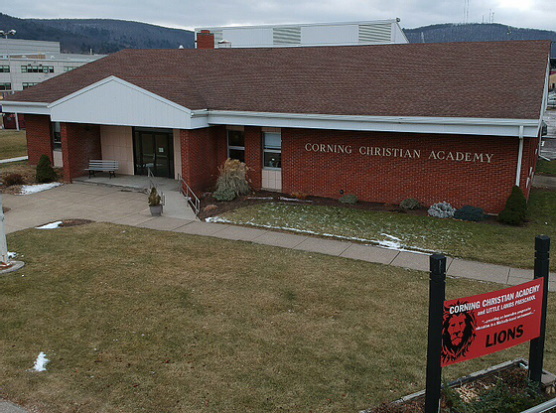
Hope Christian Academy
Hope Christian Academy was founded in August of 1987 as a ministry of Hope Church, a non-denominational church in Painted Post, New York. We are a school that works with parents to build a foundation of Godly character, work ethic, and academics into young lives in preparation for a successful future in service to God and man. Grades K-8 are held.For more information: Hope Christian Academy Website
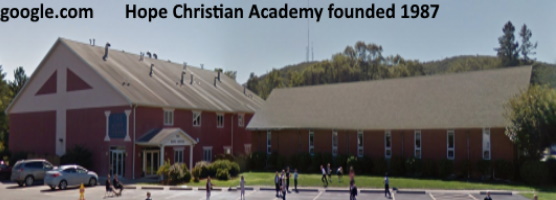
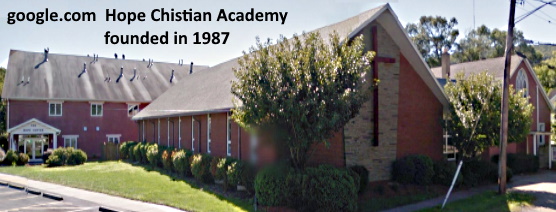
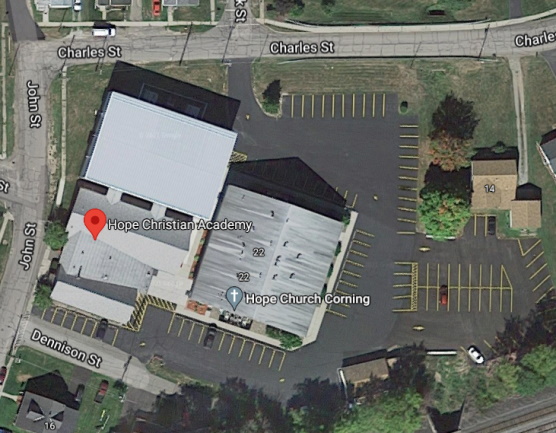
Alternative School for Math and Science
ASMS was founded in 2003 by a group of parents and community members searching for a middle school learning environment to best suit the needs of their children. Concerned about global and local data indicating declining levels of educational achievement in the United States, yet inspired by the belief that excellence in education empowers students to achieve their dreams for tomorrow, the founders created a new educational model. The Alternative School for Math & Science began in a beautifully renovated historic schoolhouse with a half-year pilot program for twenty 6th, 7th and 8th grade students. Our footprint has grown significantly since inception and currently our 29 faculty members serve a total of 144 students in 6th, 7th and 8th grades.In 2010, ASMS was granted an Absolute Charter by the New York State Board of Regents, and in 2015 ASMS was awarded national accreditation by Middle States Association of Colleges and Schools.
Source: Alternative School for Math and Science [History]
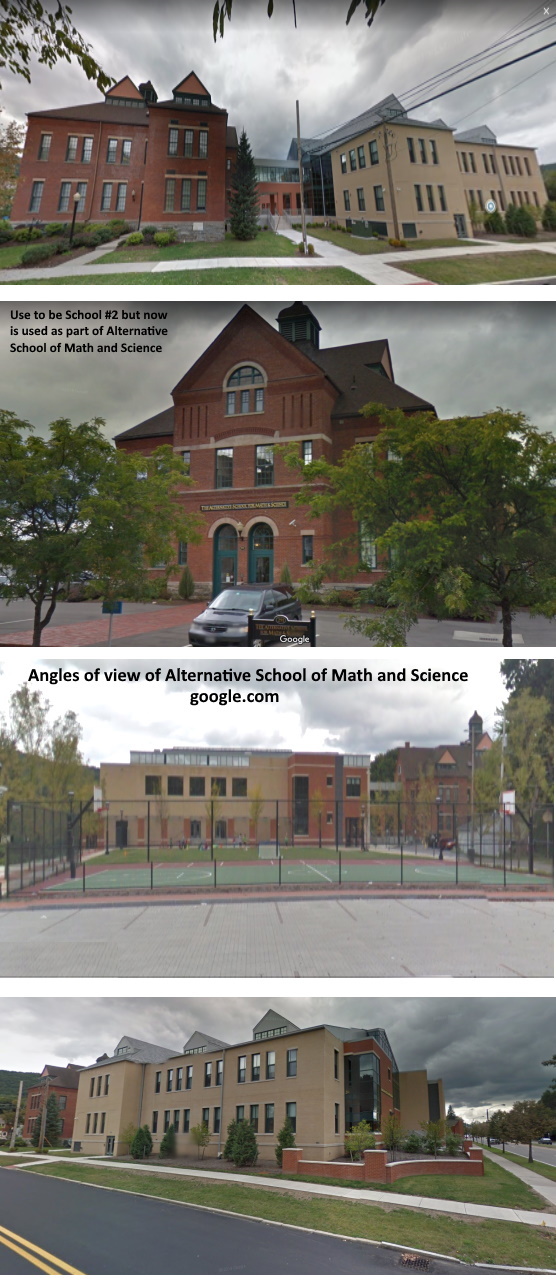
Early Schools [until 1954]
Caton had 11 one room schools. In 1956, consolidation of 62 school districts formed the Corning-Painted Post School District. Some students there still attended one-room schools until 1957. Until consolidation, scarcely half of the one-room students in the Corning area went on to high school, even though that option was available to them. That percentage shot up instantly with consolidation into larger elementary and junior-high schools.Source: Corning Leader Article [One Room Schools]

Source: Corning Leader [Article: One Room School]
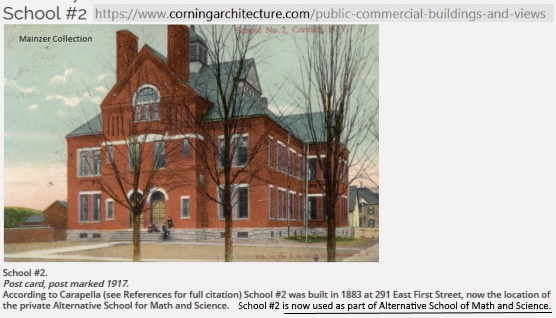
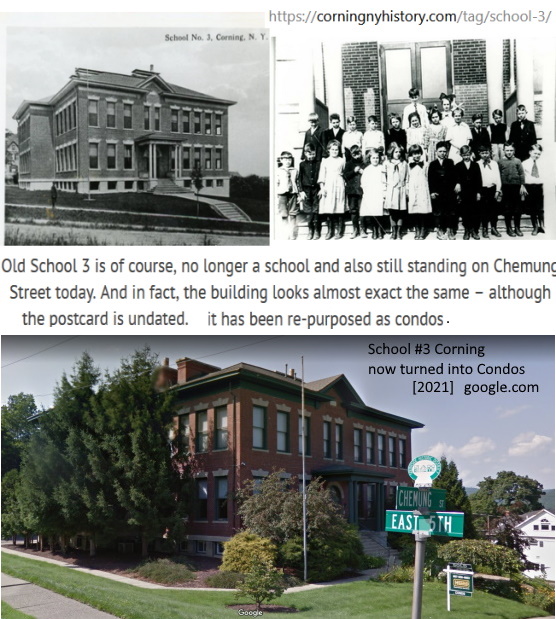
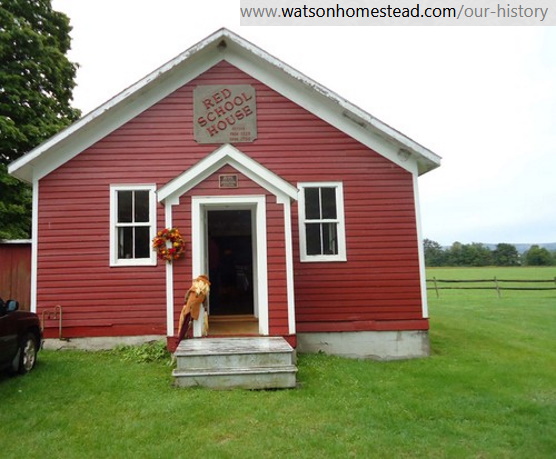
District School Number Five, also known as "The Little Red Schoolhouse," is a historic one room school building located at Campbell in Steuben County, New York. It was built during the spring and summer of 1839 with a hand hewn timber frame of mortise and tenon construction. The schoolhouse is part of the Watson Homestead Conference and Retreat Center [Golf Rd, Campbell, NY], deeded to the Genesee Conference of the Methodist Church by IBM founder Thomas J. Watson, Sr. Watson attended the school as a child. Also on the property is a small frame structure that served as privy and woodshed. It was listed on the National Register of Historic Places in 2001.
Source: Wikipedia.org [District School #5]
Browntown School [District 5] One Room School one of 11 one room schools in Caton area. This school is now included at Heritage Village in Corning, NY
Source:
Heritage Village [Browntown School]
Facebook: Patterson Inn Museum
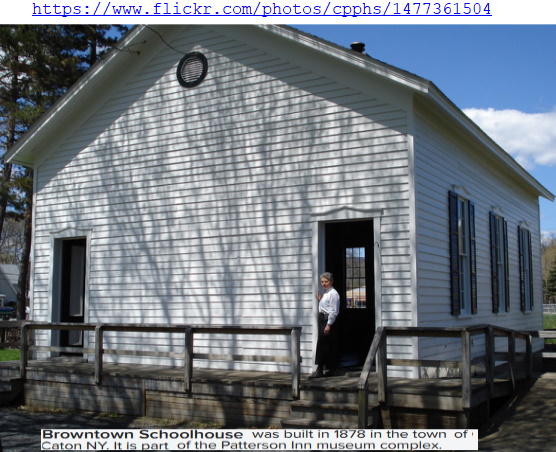
Caton had 11 one room schools. In 1956, consolidation of 62 school districts formed the Corning-Painted Post School District. Some students there still attended one-room schools until 1957. Until consolidation, scarcely half of the one-room students in the Corning area went on to high school, even though that option was available to them. That percentage shot up instantly with consolidation into larger elementary and junior-high schools.
Source: Corning Leader Article [One Room Schools]

In 1888,Northside Blodgett Grammar School [corner of Princeton and Cayuta St] was located on the same land area as the Northside High School would be located. In 1903, an annex was added on the west end of the building and the Teachers Training class moved into the building. In 1888, Knoxville Village ( which is now known as Corning, N.Y.'s Northside) built a brick school on the Northeast corner of Jennings and Sly Ave. (Now the Gregg Elementary School paved School Ground). There were 120 students grade 1-8 and classrooms for high school. In 1895, additional classrooms were added on the east end of the building.
In 1910, another high school was approved. It was built on the opposite side of Jennings St. on the east side of Flint Ave. (Between what is now Jennings St. and the Patterson Inn .-the parking lot for the Hugh Gregg Elementary School). The Grammar School remained in the old building across the street. In 1925 ,still another high school was approved on Princeton and Kingsbury Ave. The 1910 building became the Northside Grammar School grades for grades 5 -7. This opened in 1927. 1-4 remained in the 1888 building (with the early additions) -(-Primary Grammar School. In 1952, $210,000 was approved for a new Elementary School (Hugh Gregg ) on Jennings and Flint Ave -west of the old school buildings. In 1953, Kindergarten to 3rd grade began attending this-while 4th to 6th graders went across the street to (Northside Grammar School ) until 1971.
In 1954 , Corning /Painted Post schools became a consolidated district. In 1957, the old Primary School was razed for an addition to the Hugh Gregg Elementary .
Public Schools [until - 2014]:
- Painted Post High School
- 1868-1963, it had grades 7-12 and was both Middle School and High School
- 1963-2014, it had grade 6-8 and became a Middle School
- In 2014, part of the Painted Post High School was used by the Administration Offices of Corning-Painted Post School District
- Northside Blodgett
- In 1888, Knoxville Village (which is now known as Corning, N.Y.'s Northside) built a brick school on the Northeast corner of Jennings and Sly Ave. (Now the Gregg Elementary School paved School Ground). There were 120 students grade 1-8 and classrooms for high school. In 1957, the 1888 school was raised for an addition to Gregg Elementary. New elementary schools were opened throughout the district. One room schools were closed.
- In 1910, a shool was built on the opposite side of Jennings St. on the east side of Flint Ave There were 120 students grade 1-8 and classrooms for high school.(Between what is now Jennings St. and the Patterson Inn .-the parking lot for the Hugh Gregg Elementary School) The Grammar School remained in the old building across the street
- until 1963, it had grades 7-12 and was a Middle School and High School.
- 1963-2014, it had grades 6-8 and was a Middle School
- In 2017, the Northside building was torn down.
- More Information:
Lindley and Northside High School History
For easier readablity: Lindley and Northside High School History Reprint/Reformat Version
- Corning Free Academy [school existed 91 yrs]
- 1920-1963, it had grades 7-12 and had a combined Middle School and High School
- 1963-2014, it had grades 6-8 and was a Middle School
- In 2014, it was sold and became an apartment building
- Farwell to CFA Article Facebook: Farwell to CFA
- Corning-Painted Post East High School
- In 1963, Northside, CFA, and Painted Post High Schools combined into either EHS or WHS High Schools grades 9-12 while Painted Post, CFA, and Northside became Middle Schools grades 6-8
- 1963-2014, it had 9-12 grades
- 1963-2014, it also was a Middle School of 6-8 grades
- Corning-Painted Post West High School
- In 1963, Northside, CFA, and Painted Post High Schools combined into either EHS or WHS High Schools grades 9-12 while Painted Post, CFA, and Northside became Middle Schools grades 6-8
- 1963-2014, West HS had 9-12 grades
- In 2014, West HS became a Middle School of 6-8 grades
- High School Learning Center
- In 2003, the HSLC is a collaborative effort among C-PP School District, Corning Community College, the local business community, local museums and area not-for-profit organizations. Since its inception in 2003, the alternative program features a curriculum that is directly aligned with the District’s learning goals. At the HSLC the emphasis is on relationships.
- Based on the understanding that the traditional high school environment does not meet the needs of all students, the HSLC was designed for capable, yet disconnected students. In many cases, these students have dropped out or are on the verge of dropping out of the traditional high schools. The program providesparticipating students with academic classes, community service and part-time paid employment or a supervised volunteer experience – a combination that emphasizes the relevance of what students are being taught while adhering to District and N.Y. State learning standards.
- Lindley-Presho Elementary
- 2010 closed school
- In 2010, it was sold to Manufacturing Automated Systems.
- Frank F Pierce Elementary
- Before 2013 was Frank F Pierce Elementary [also known as Frank F Pierce Early Childhood Center] had grades K through 5. Until 2013, Frank F. Pierce Early Childhood Center [Also known as Frank F. Pierce Elementary School] was located at 3805 Meads Creek Road Painted Post, NY serving grades PK in Steuben County. The Elementary Enrichment Program was for qualifying Gifted and Talented students in 2nd through 5th grades. The students had the opportunity to meet one day a week in their own school in small groups over the course of one semester. The program was three days a week: Tuesday, Wednesday and Thursday, and the students had enrichment for one and a half hours. It was on Meads Creek Rd, Coopers Plains, NY Source: NY Schools Report on Frank Pierce Early Childhood Center
- In 2013, the former Frank Pierce Early Childhood Center in Coopers Plains was sold to CareFirst, which provides hospice services. Carefirst currently operating at the former school. Source: Star Gazette Article on the sale of Frank Pierce Early Childhood Center
- Caton Elementary
- The school had grades K-6
- School Closed. Pathways occupied the building after the school closed until Pathways moved to Denison Parkway West, Corning, New York. In 2021, it is being used as pre-primary classrooms
- South Corning Elementary
- The school had grades K-6. It was located on Maple St in between Maple and Elm Sts., South Corning, NY
- School Closed. It currently is used by the the Village of South Corning for their offices and such. Office space in the building is available for rent. The building has the Town of Corning Offices.
- South Corning Elementary students moved to Severn Elementary when the school closed
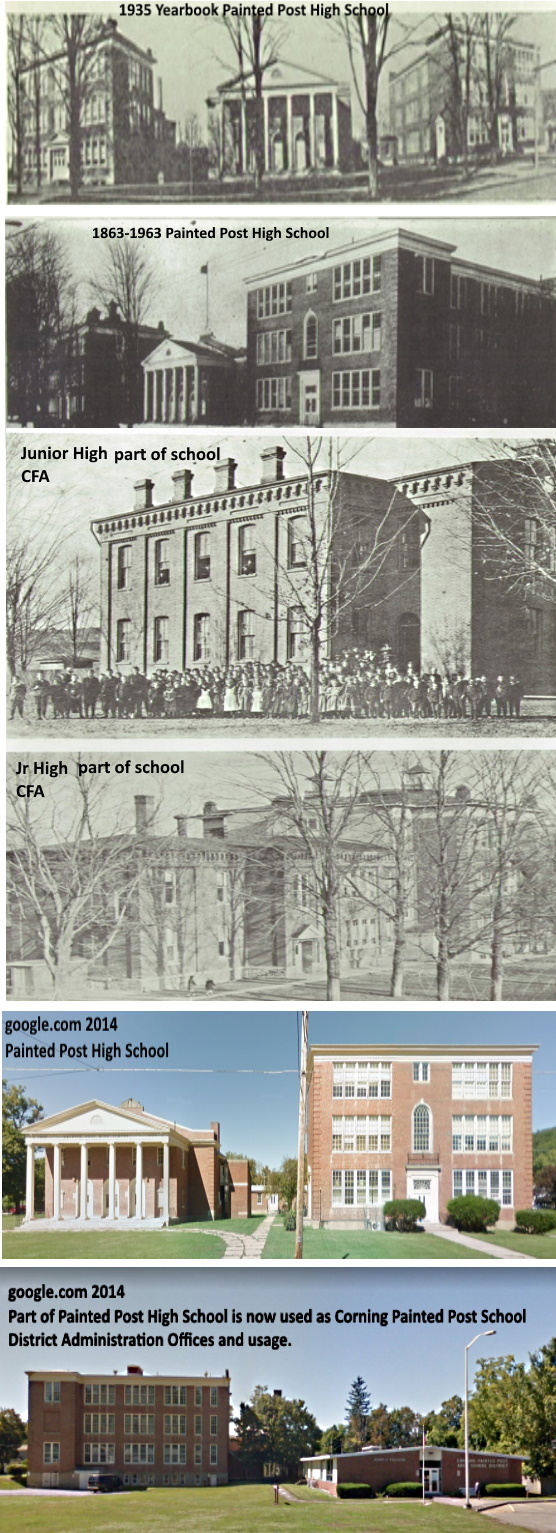
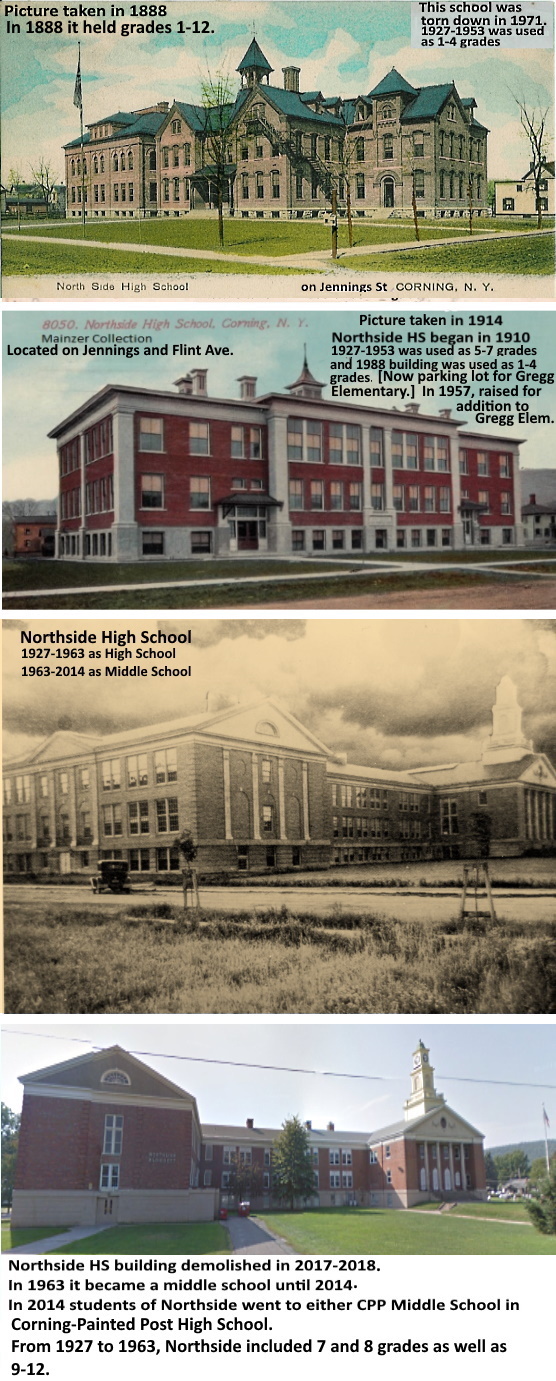
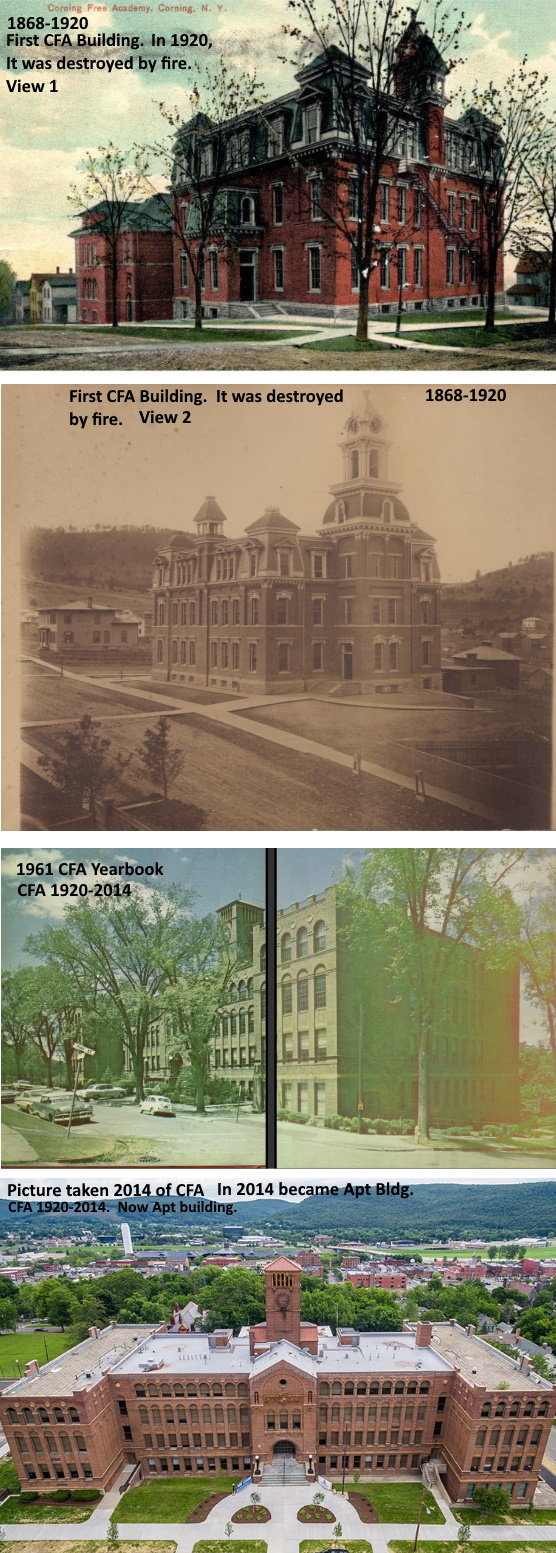
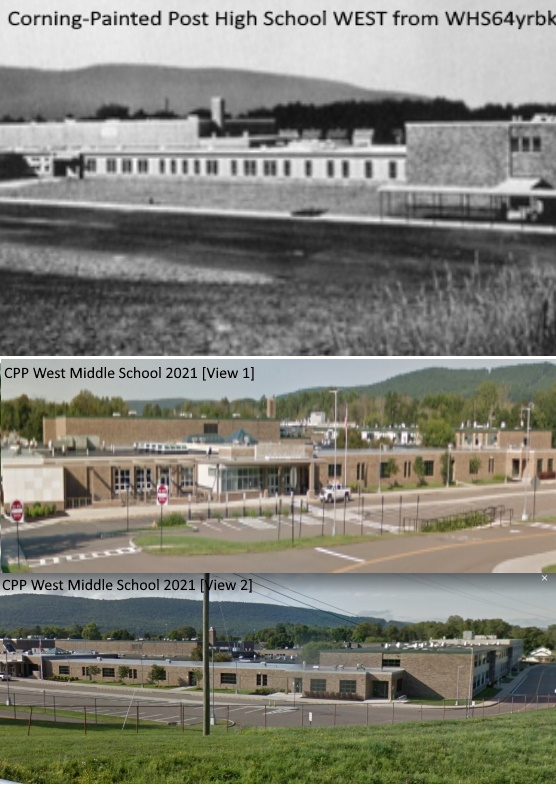
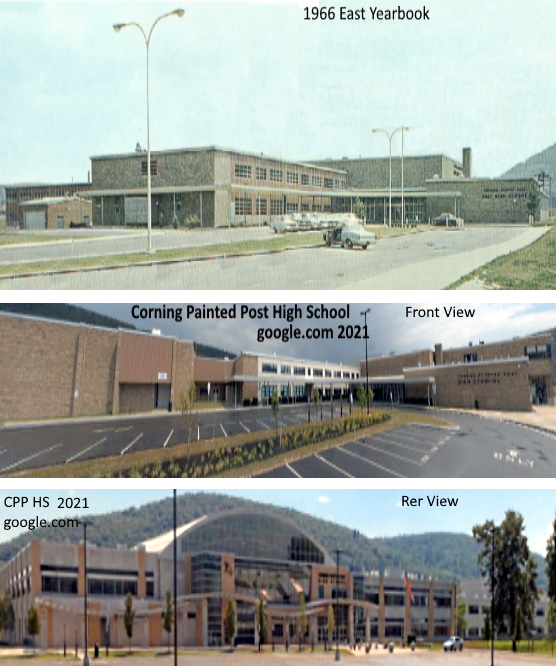
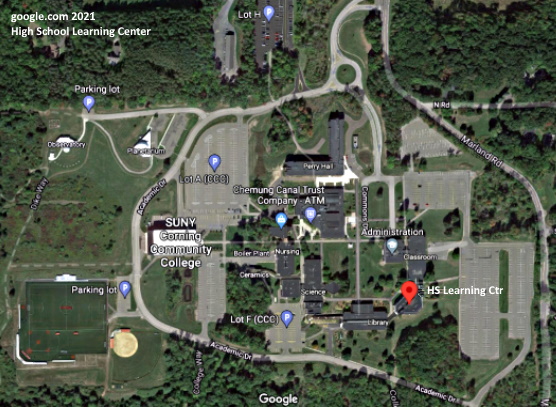
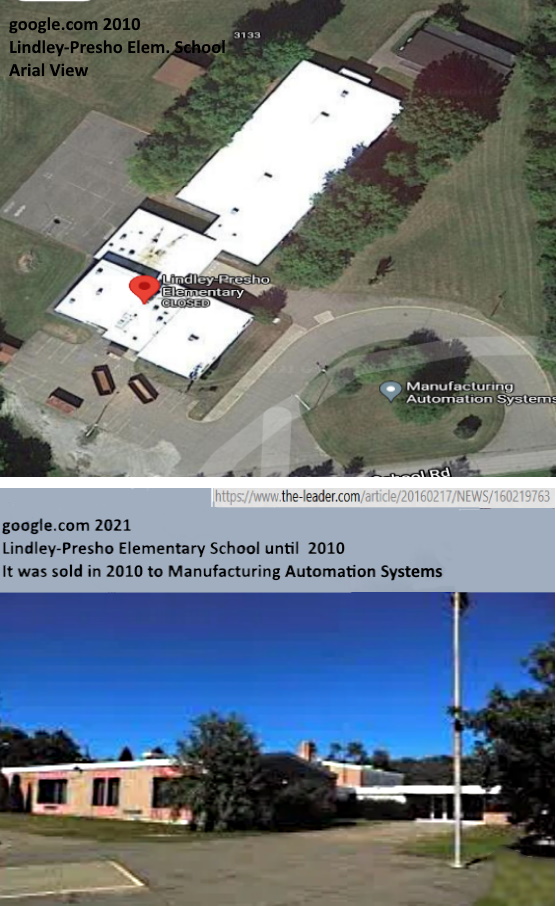
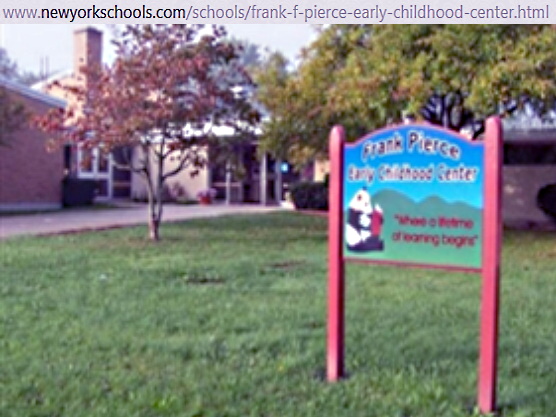

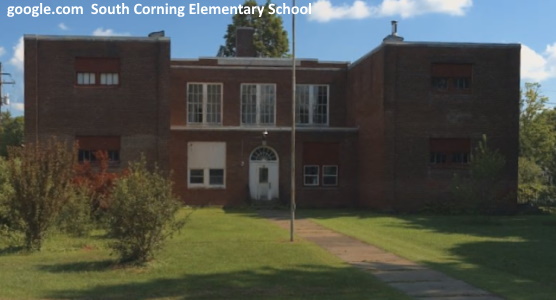
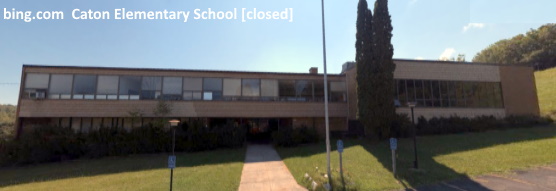
Public Schools [2014-Current]:
In 2010 a referendum was passed that reconfigured the school district's secondary schools; both of the previous middle schools combined and moved into the former "West High School" building while both of the high schools combined at the former "East High School" campus. This reconfiguration / building project was finished by the beginning of the 2014–2015 school year.
In addition to the public and private school options, the Corning-Painted Post District also partners with a regional P-Tech school (known as "The Greater Southern Tier STEM Academy") and sends selected students to a grade 9-14 program on their campus.[20]
Public elementary schools include: [2014-Current]
- Hugh W. Gregg
- Winfield Street
- William E. Severn
- Calvin U. Smith
- Erwin Valley
- Frederick Carder
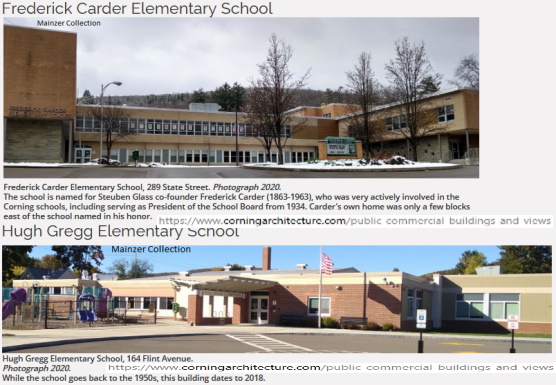
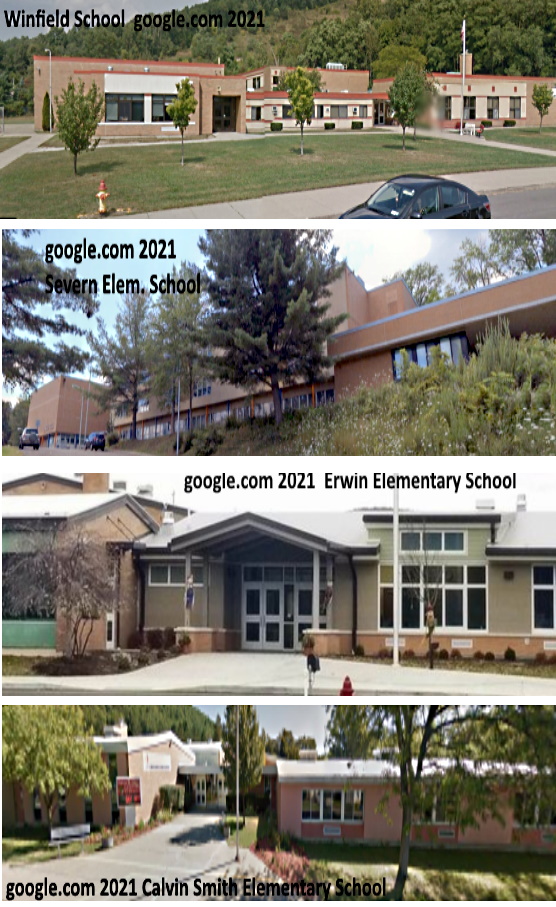
Public middle schools include: [2014-Current]
- Corning Painted Post Middle School {Painted Post}
- High School Learning Center (HSLC) {CCC in Town of Corning}
- Corning Painted Post High School {Corning}
- The Alternative School for Math and Science [ASMS] {Corning}
- All Saints Academy [a K–8 Catholic school] {Corning}
- Corning Christian Academy [a P–12 evangelical Christian school] {Corning}
- Corning Community College {Town of Corning}

